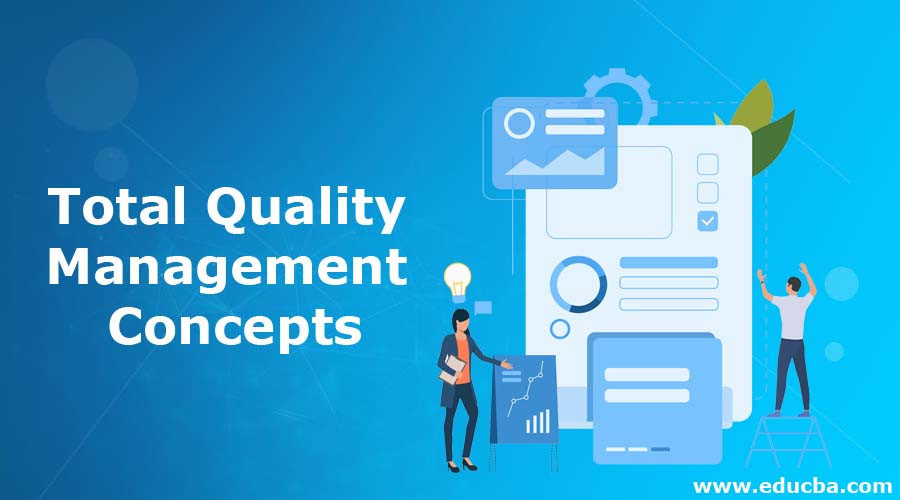Updated May 24, 2023

Introduction to Total Quality Management Concepts
Before diving deep into this concept, let’s define each term separately, as this will help us better understand these Total Quality Management Concepts.
- Total: As the name suggests, it refers to the entire or whole organization.
- Quality: Even this is self-explanatory, the quality of the company’s products and services.
- Management: It can refer to the people running the organization and how they manage, direct and control it.
Thus it refers to running the organization effectively and productively and developing existing systems and procedures to operate efficiently. It also focuses on enhancing customer satisfaction and trying to meet customer expectations. The objective of the management is to increase the organization’s internal productivity and customer satisfaction.
List of Popular Concepts of Total Quality Management
To achieve this, specific guidelines assist management in enhancing their systems; these guidelines can also be viewed as concepts.
Below is a list of some of the popular concepts:
1. Continuous Quality Improvement
Customer satisfaction is key to the survival of any business, and to satisfy customers, business needs to constantly work towards improving their quality. They should have certain benchmarks that help them maintain basic standards and quality, and in no circumstance should the quality of their products and services fall below these standards.
2. Employee Involvement
Giving employees autonomy in conducting their daily tasks and involving them in the decision-making process goes a long way in retaining employees, gaining their loyalty, and increasing their motivation and commitment toward their work. When management implements employee suggestions, it boosts their morale and makes them feel management cares for them. We should also reward employees based on their performance. Rewarding employees for implementing innovative suggestions send a signal to others, encouraging them to seek and provide innovative solutions actively. This will significantly enhance their productivity.
3. Long-Term Planning
The organization should work on formulating its plan for the future, that is, for the next 5-10 years, what they plan to achieve and how they plan to do it. And then work towards achieving this; they should make decisions that support their long-term objective and have a periodic review phase to compare if they are on the right track. Such plans will also help them acquire the right kind of human talent which supports their objectives and has the skills needed to achieve them.
4. Openwork Environment
Managers should welcome suggestions from employees and encourage them to do so without considering prejudice. Organizational structure should be relatively flat so senior managers are easily accessible and consider ideas provided by juniors.
List of Additional Concepts of Total Quality Management
Apart from the concepts mentioned above, below is a list of additional concepts. It should be noted that there are a lot of theories for total quality management, but underlying methodology and concepts are intertwined.
1. Be Customer Focused: All the actions and decisions an organization takes must keep its customer in mind, that is, how will the customers benefit from this. It should enhance overall customer satisfaction. The organization can take several measures, like training employees and improving internal process management.
2. Total Employee Involvement: Only when employees are involved in the decision-making process will they work efficiently and develop innovative ways of enhancing the customer experience. Employees feel empowered if senior management considers their suggestion and implements it. Overall, employees become happy.
3. Process-Centered: Enhancing quality must focus on the organization’s primary process. Enhancing and innovating the central process is key to high-quality management. And all decisions must be made keeping the central process in mind.
4. Integrated Approach: This point applies to companies with multiple divisions and subsidiaries working collectively. Considering all these divisions and how they are integrated, any decision must be taken. It should not be that a decision increases the efficiency of one division but reduces the other. We should collect the approach and consider its impact on all divisions.
5. Continuous Improvement: If something has worked in the past, where organization effectiveness and customer experience increased, it does not mean it will work again in the future. The culture of the organization should focus on and encourage continuous improvement. The company should reward employees who find innovative ways to improve.
6. Fact-Based Decision-Making: All decisions to be implemented should be backed up by concrete facts and evidence. It is important not to get swayed away by emotions or have a hidden personal agenda when making and finalizing decisions.
7. Communication: The effectiveness of successful management depends on how well the decisions taken are communicated to employees so that they are aware of them and can use them to enhance their work. Effective communication is essential to successfully implement policy changes that impact the customer experience.
8. Strategic and Systematic Implementation: This point focuses on the timing of implementation. Making the right decisions at the right point in time is crucial for enhancing quality. Strategically it is essential as well because if a competitor is working on similar policies or strategies, it should not get the first movers advantage.
Conclusion
Thus we would like to conclude this article by stating that total quality management is enhancing traditional ways of doing business and bringing them in line with current trends and technology developments. Given the domestic and international competition, organizations must find new and innovative ways to survive. Management needs to take responsibility for the survival of their organization and encourage a culture of innovation. Employees should have autonomy. Companies can significantly enhance their productivity and overall customer satisfaction with smart decisions.
Recommended Articles
This has been a guide to Total Quality Management Concepts. Here we have discussed some popular and additional concepts of total quality management. You can also go through our other suggested articles to learn more –
